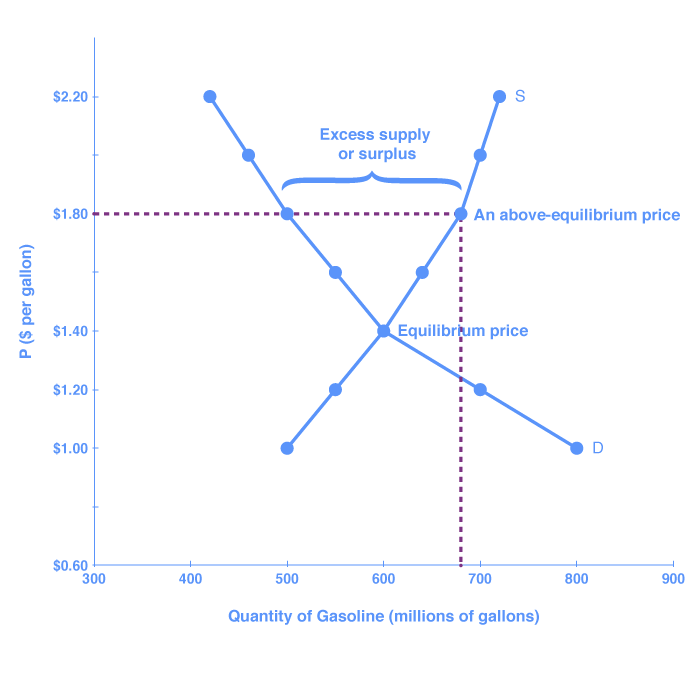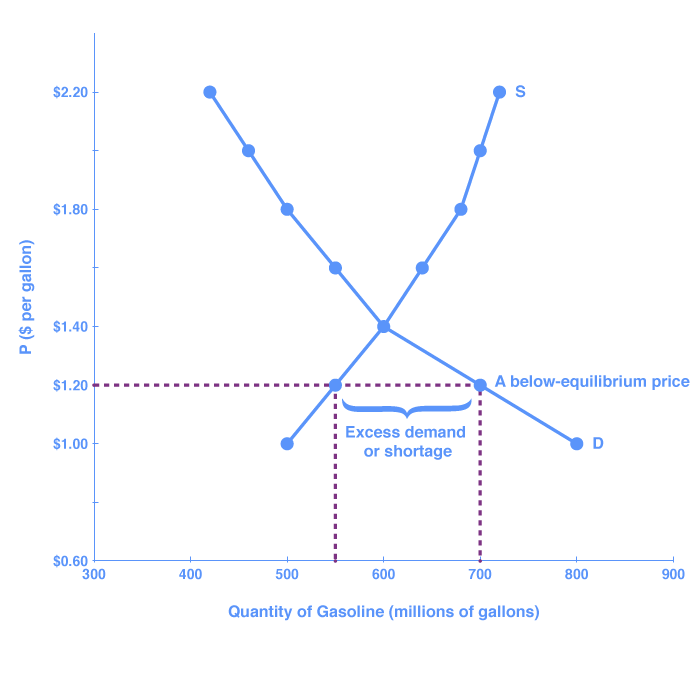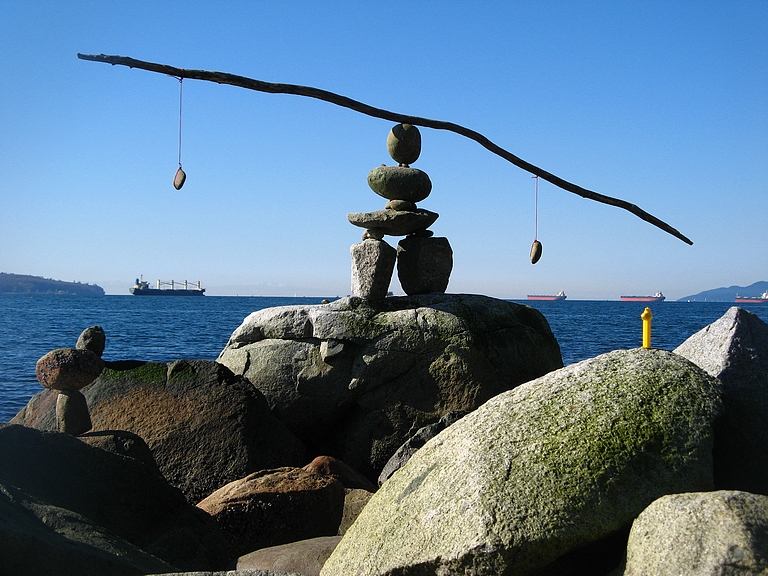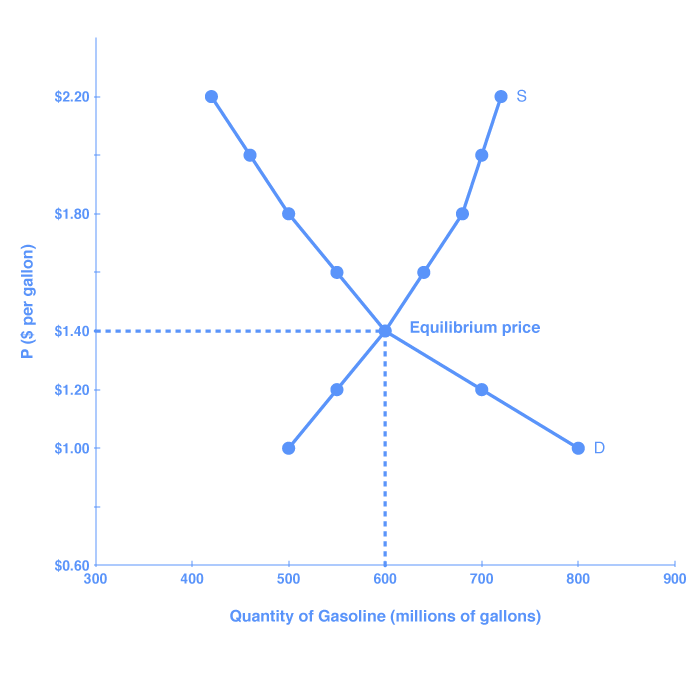The Process Continues Until the Market is Finally ina Equilibrium
Learning Objectives
- Define equilibrium price and quantity and identify them in a market
- Define surpluses and shortages and explain how they cause the price to move towards equilibrium
Demand and Supply
In order to understand market equilibrium, we need to start with the laws of demand and supply. Recall that the law of demand says that as price decreases, consumers demand a higher quantity. Similarly, the law of supply says that when price decreases, producers supply a lower quantity.
Because the graphs for demand and supply curves both have price on the vertical axis and quantity on the horizontal axis, the demand curve and supply curve for a particular good or service can appear on the same graph. Together, demand and supply determine the price and the quantity that will be bought and sold in a market. These relationships are shown as the demand and supply curves in Figure 1, which is based on the data in Table 1, below.

Figure 1. The supply and demand curves for gasoline.
| Table 1 . Price, Quantity Demanded, and Quantity Supplied | ||
|---|---|---|
| Price (per gallon) | Quantity demanded (millions of gallons) | Quantity supplied (millions of gallons) |
| $1.00 | 800 | 500 |
| $1.20 | 700 | 550 |
| $1.40 | 600 | 600 |
| $1.60 | 550 | 640 |
| $1.80 | 500 | 680 |
| $2.00 | 460 | 700 |
| $2.20 | 420 | 720 |
If you look at either Figure 1 or Table 1, you'll see that at most prices the amount that consumers want to buy (which we call the quantity demanded) is different from the amount that producers want to sell (which we call the quantity supplied). What does it mean when the quantity demanded and the quantity supplied aren't the same? The answer is: a surplus or a shortage.
Surplus or Excess Supply
Let's consider one scenario in which the amount that producers want to sell doesn't match the amount that consumers want to buy. Consider our gasoline market example. Imagine that the price of a gallon of gasoline were $1.80 per gallon. This price is illustrated by the dashed horizontal line at the price of $1.80 per gallon in Figure 2, below.

Figure 2. A price above equilibrium creates a surplus.
At this price, the quantity demanded is 500 gallons, and the quantity of gasoline supplied is 680 gallons. You can also find these numbers in Table 1, above. Now, compare thequantity demanded and quantity supplied at this price. Quantity supplied (680) is greater than quantity demanded (500). Or, to put it in words, the amount that producers want to sell is greater than the amount that consumers want to buy. We call this a situation of excess supply (since Qs > Qd) or a surplus. Note that whenever we compare supply and demand, it's in the context of a specific price—in this case, $1.80 per gallon.
With a surplus, gasoline accumulates at gas stations, in tanker trucks, in pipelines, and at oil refineries. This accumulation puts pressure on gasoline sellers. If a surplus remains unsold, those firms involved in making and selling gasoline are not receiving enough cash to pay their workers and cover their expenses. In this situation, some firms will want to cut prices, because it is better to sell at a lower price than not to sell at all. Once some sellers start cutting prices; others will follow to avoid losing sales. These price reductions will, in turn, stimulate a higher quantity demanded.
How far will the price fall? Whenever there is a surplus, the price will drop until the surplus goes away. When the surplus is eliminated, the quantity supplied just equals the quantity demanded—that is, the amount that producers want to sell exactly equals the amount that consumers want to buy. We call this equilibrium, which means "balance." In this case, the equilibrium occurs at a price of $1.40 per gallon and at a quantity of 600 gallons. You can see this in Figure 2 (and Figure 1) where the supply and demand curves cross. You can also find it in Table 1 (the numbers in bold).
Try It
Shortage or Excess Demand
Let's return to our gasoline problem. Suppose that the price is $1.20 per gallon, as the dashed horizontal line at this price in Figure 3, below, shows. At this price, the quantity demanded is 700 gallons, and the quantity supplied is 550 gallons.

Figure 3. A price below equilibrium creates a shortage.
Quantity supplied (550) is less than quantity demanded (700). Or, to put it in words, the amount that producers want to sell is less than the amount that consumers want to buy. We call this a situation of excess demand (since Qd > Qs) or a shortage.
In this situation, eager gasoline buyers mob the gas stations, only to find many stations running short of fuel. Oil companies and gas stations recognize that they have an opportunity to make higher profits by selling what gasoline they have at a higher price. These price increases will stimulate the quantity supplied and reduce the quantity demanded. As this occurs, the shortage will decrease. How far will the price rise? The price will rise until the shortage is eliminated and the quantity supplied equals quantity demanded. In other words, the market will be in equilibrium again. As before, the equilibrium occurs at a price of $1.40 per gallon and at a quantity of 600 gallons.
Generally any time the price for a good is below the equilibrium level, incentives built into the structure of demand and supply will create pressures for the price to rise. Similarly, any time the price for a good is above the equilibrium level, similar pressures will generally cause the price to fall.
As you can see, the quantity supplied or quantity demanded in a free market will correct over time to restore balance, or equilibrium.

Figure 4. Equilibrium is the point where the amount that buyers want to buy matches the point where sellers want to sell.
Equilibrium: Where Supply and Demand Intersect
When two lines on a diagram cross, this intersection usually means something. On a graph, the point where the supply curve (S) and the demand curve (D) intersect is the equilibrium. The equilibrium price is the only price where the desires of consumers and the desires of producers agree—that is, where the amount of the product that consumers want to buy (quantity demanded) is equal to the amount producers want to sell (quantity supplied). This mutually desired amount is called the equilibrium quantity. At any other price, the quantity demanded does not equal the quantity supplied, so the market is not in equilibrium at that price. It should be clear from the previous discussions of surpluses and shortages, that if a market is not in equilibrium, market forces will push the market to the equilibrium.
If you have only the demand and supply schedules, and no graph, you can find the equilibrium by looking for the price level on the tables where the quantity demanded and the quantity supplied are equal (again, the numbers in bold in Table 1 indicate this point).
Finding Equilibrium with Algebra
We've just explained two ways of finding a market equilibrium: by looking at a table showing the quantity demanded and supplied at different prices, and by looking at a graph of demand and supply. We can also identify the equilibrium with a little algebra if we have equations for the supply and demand curves. Let's practice solving a few equations that you will see later in the course. Right now, we are only going to focus on the math. Later you'll learn why these models work the way they do, but let's start by focusing on solving the equations. Suppose that the demand for soda is given by the following equation:
[latex]Qd=16–2P[/latex]
where Qd is the amount of soda that consumers want to buy (i.e., quantity demanded), and P is the price of soda. Suppose the supply of soda is
[latex]Qs=2+5P[/latex]
where Qs is the amount of soda that producers will supply (i.e., quantity supplied). (Remember, these are simple equations for lines). Finally, recall that the soda market converges to the point where supply equals demand, or
[latex]Qd=Qs[/latex]
We now have a system of three equations and three unknowns (Qd, Qs, and P), which we can solve with algebra. Since
[latex]Qd=Qs[/latex],
we can set the demand and supply equations equal to each other:
[latex]\begin{array}{c}\,\,Qd=Qs\\16-2P=2+5P\end{array}[/latex]
Step 1: Isolate the variable by adding 2P to both sides of the equation, and subtracting 2 from both sides.
[latex]\begin{array}{l}\,16-2P=2+5P\\-2+2P=-2+2P\\\,\,\,\,\,\,\,\,\,\,\,\,\,\,\,14=7P\end{array}[/latex]
Step 2: Simplify the equation by dividing both sides by 7.
[latex]\begin{array}{l}\underline{14}=\underline{7P}\\\,\,\,7\,\,\,\,\,\,\,\,\,\,7\\\,\,\,\,2=P\end{array}[/latex]
The equilibrium price of soda, that is, the price where Qs = Qd will be $2. Now we want to determine the quantity amount of soda. We can do this by plugging the equilibrium price into either the equation showing the demand for soda or the equation showing the supply of soda. Let's use demand. Remember, the formula for quantity demanded is the following:
[latex]Qd=16-2P[/latex]
Taking the price of $2, and plugging it into the demand equation, we get
[latex]\begin{array}{l}Qd=16–2(2)\\Qd=16–4\\Qd=12\end{array}[/latex]
So, if the price is $2 each, consumers will purchase 12. How much will producers supply, or what is the quantity supplied? Taking the price of $2, and plugging it into the equation for quantity supplied, we get the following:
[latex]\begin{array}{l}Qs=2+5P\\Qs=2+5(2)\\Qs=2+10\\Qs=12\end{array}[/latex]
Now, if the price is $2 each, producers will supply 12 sodas. This means that we did our math correctly, since
[latex]Qd=Qs[/latex]
and both Qd and Qs are equal to 12. That confirms that we've found the equilibrium quantity.
Watch It
Watch this video for a closer look at market equilibrium:
Equilibrium and Economic Efficiency
Equilibrium is important to create both a balanced market and an efficient market. If a market is at its equilibrium price and quantity, then it has no reason to move away from that point, because it's balancing the quantity supplied and the quantity demanded. However, if a market is not at equilibrium, then economic pressures arise to move the market toward the equilibrium price and equilibrium quantity. This happens either because there is more supply than what the market is demanding or because there is more demand than the market is supplying. This balance is a natural function of a free-market economy.
Also, a competitive market that is operating at equilibrium is an efficient market. Economists typically define efficiency in this way: when it is impossible to improve the situation of one party without imposing a cost on another. Conversely, if a situation is inefficient, it becomes possible to benefit at least one party without imposing costs on others.

Figure 5. Demand and Supply for Gasoline: Equilibrium. At this equilibrium point, the market is efficient because the optimal amount of gasoline is being produced and consumed.
Efficiency in the demand and supply model has the same basic meaning: the economy is getting as much benefit as possible from its scarce resources, and all the possible gains from trade have been achieved. In other words, the optimal amount of each good and service is being produced and consumed. We will explore this important concept in detail in the next module on applications of supply and demand.
Try It
Glossary
- efficiency:
- when the optimal amount of goods are produced and consumed, minimizing waste
- equilibrium:
- price and quantity combination where supply equals demand
- equilibrium price:
- the (only) price where the quantity supplied in a market equals the quantity demanded
- equilibrium quantity:
- the quantity both supplied and demanded at the equilibrium price
- shortage (or excess demand):
- situation where the quantity demanded in a market is greater than the quantity supplied; occurs at prices below the equilibrium
- surplus (or excess supply):
- situation where the quantity demanded in a market is less than the quantity supplied; occurs at prices above the equilibrium
Contribute!
Did you have an idea for improving this content? We'd love your input.
Improve this pageLearn More
Source: https://courses.lumenlearning.com/wm-microeconomics/chapter/equilibrium-surplus-and-shortage/
0 Response to "The Process Continues Until the Market is Finally ina Equilibrium"
Post a Comment